"The slogan "He has not died and will never die" - which seems to echo the French Renaissance formula "Le roi est mort, vive le roi!" [The king is dead, long live the king!] - appeared in the newspaper Petrogradskaia pravda on 25 January."
Dickerman, p. 78. |
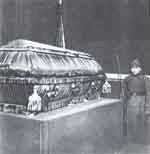 |
 |
|
| The first Mausoleum, built in 1924. |
 |
 |
|
| Commemoration: first anniversary of Lenin's death. |
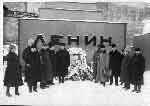 |
 |
|
|
"The ingenuity of the conceit lies in the complete identity of the body-as-politic and the body proper. The problematic itself is old: if power is identified with the life of a body, the death of the body is the death of power, unless the real is transformed into the symbolic.
Portraiture traditionally makes claims to providing a likeness, a copy faithful in some way to its subject. The preserved body of Lenin aims higher, offering the original itself."
Dickerman, p. 80.
|
|
|
"Leonid Krasin' funeral oration in 1921: `I am certain, that the time will come, when science will become all-powerful, and that it will be able to recreate a deceased organism. I am certain that the time will come when one will be able to use the elements of a person's life to recreate the physical person.`"
In.: Merridale, p. 192.
(Leonid Krasin was the leader of the Immortalizing Committee set up in January, 1924 that was in charge of organizing Lenin`s funeral, the embalming of Lenin`s body and the construction of the Lenin Mausoleum.)
|
|
|
"Comrades, workers and peasants! I have a great request to make of you: do not allow your grief for Ilich to express itself in the external veneration of his person. Do not build memorials to him, palaces named after him. (...) All of this meant so little to him in his lifetime..."
Krupskaia`s letter published in Pravda, January 29, 1924.
|
|
|
"The mere idea is inconceivable that we bury Vladimir Ilich`s body into the soil."
Zinoviev: Six Days That Russia Never Forget. Pravda, January 30, 1924.
Zinoviev was a member of the top leadership of the party, Lenin's old comrade who, unlike other prominent Bolshevik leaders - Bukharin, Trotsky, Kamenev - supported Stalin's (and Krasin's) idea of embalming Lenin.
|
|
|
"Vladimir Ilyich is eternal... How shall we honor his memory? How will we mark his grave? In architecture the cube is eternal. Everything proceeds from the cube, the entire range of architectural creation. Let the mausoleum, which we shall erect as a monument to Vladimir Ilyich, derive from a cube."
A.V. Shchusev, later architect of the Lenin Mausoleum, on a meeting of architects convened by Leonid Krasin on 23 January, 1924. Eventually, the 1925 competiton was declared unsuccesful due to the inadequacy of the proposed plans. Therefore, the Krasin-commission simply asked Shchusev to complete his wooden design in stone.
|
|
| Preliminary designs for the interior of the mausoleum. |
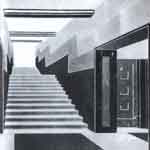 |
 |
|
| Preliminary designs for the interior of the mausoleum. |
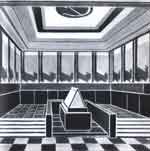 |
 |
|
| The construction work of the second mausoleum, 1925. |
 |
 |
|
| The second mausoleum, built of wood. |
 |
 |
|
| The final mausoleum, built of red marble in 1930. |
 |
 |
|
| Lenin, laying in the Mausoleum. |
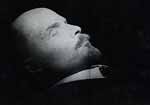 |
 |
|
|
"To represent is to make the dead man come back as if he were present and living"
Marin, p. 5.
|
|
|
Sources:
- Leah Dickerman, Lenin in the Age of Mechanical Reproduction In: Disturbing Remains: Memory, History, and Crisis in the Twentieth Century, Edited by Michael S. Roth and Charles G. Salas, Published by the Getty Research Institute.
- Catherine Merridale, Night of Stone - Death and Memory in Russia. Granta Books, London, 2000.
- Louis Marin, Portrait of the King. University of Minnesota Press, Minneapolis 1988.
|
|
|
|











